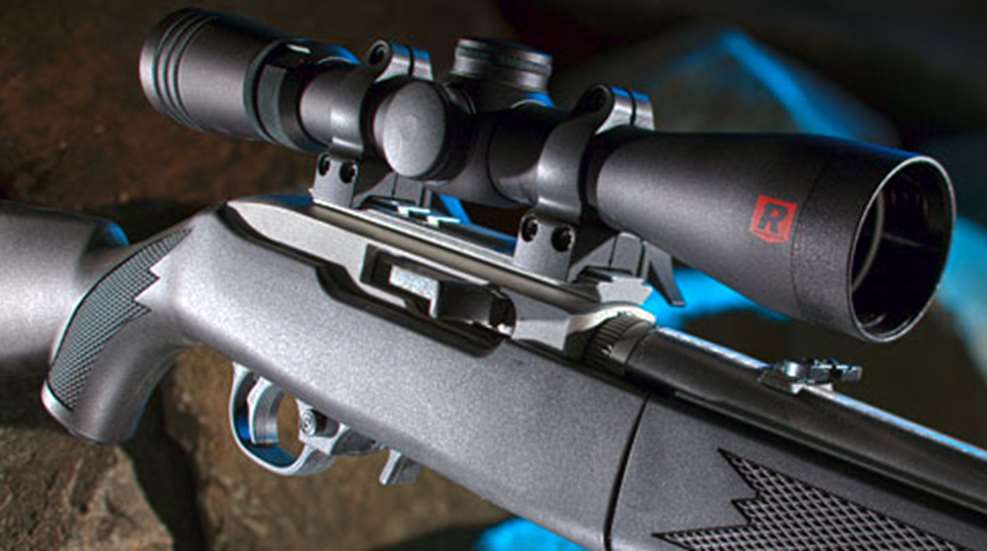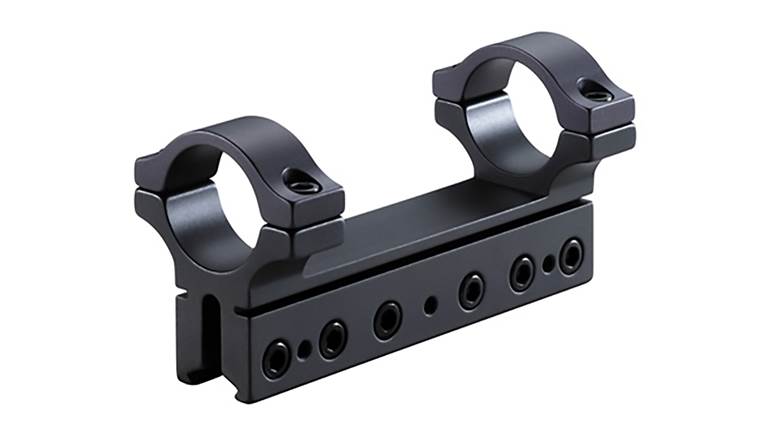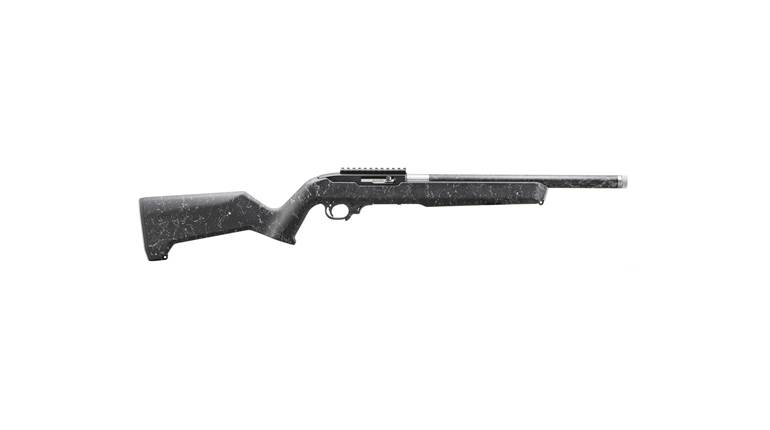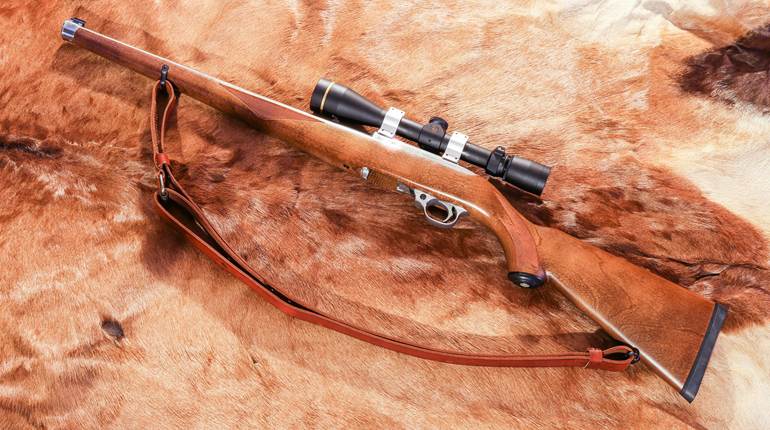
With more than 5 million produced since 1964, Sturm, Ruger & Co.’s blowback-operated semi-automatic 10/22 rimfire rifle is one of the world’s most successful commercial firearms. Reasons include its unfailing reliability, excellent accuracy and modest price. In addition, the 10/22’s basic design is adaptable—the barrel can be easily changed—and there is broad selection of aftermarket parts and magazines available, which has spawned innumerable configurations. But, until recently, a factory takedown version of the 10/22 was little more than a wish.
That wish is now a reality in the form of the 10/22 Takedown—a synthetic and stainless carbine that separates into two major sections quickly and easily without tools. Broken down, the receiver/buttstock section measures 20 inches in length. The barrel/fore-end section measures 18 1/2 inches in length. The new gun has 19 unique parts, including the receiver, which cannot be retrofitted to a non-takedown model.
Its two-piece carbine-style polymer stock features a curved, checkered butt and molded-in checkering on the pistol grip and fore-end. The 18 1/2-inch, stainless-steel barrel has a dovetail slot at its rear that mounts a fully adjustable folding leaf sight while an integral band-style boss near the muzzle mounts a blade topped with a 0.650 inch brass bead. A silver-anodized aluminum scope rail that accepts both Weaver-style and 3/8 inch dovetail rings is included and mounts to the receiver with four slotted machine screws.
The Takedown accepts standard 10/22 magazines and comes with one flush-fitting, 10-round rotary unit. Controls are the familiar crossbolt safety at the front of the polymer trigger housing, an extended paddle-style polymer magazine release and a steel blade located between the two that locks and releases the bolt.
Also unique to the 10/22 Takedown is an included black nylon zippered carry bag with interior sleeves that accommodate the rifle’s sections along with two exterior pockets for accessories. It has a carry handle at its top and D-rings at its corners that could accommodate backpack straps, but they are not included. The case’s size and shape allows for discreet transport of the rifle along with spare magazines, ammunition, tools and other supplies.
Separating the 10/22 Takedown’s sections is a simple matter of retracting the bolt and locking it back then pressing forward on the spring-loaded locking lever, which protrudes from a recess on the underside of the barrel/fore-end section, and simultaneously rotating that section 45 degrees counterclockwise. Reassembly requires aligning a machined flat section on the barrel shoulder’s lower right quadrant with the top surface of the clamp then pressing the two sections together before rotating them from clockwise.
The takedown mechanism consists of a tapered, spring-loaded locking plunger in the barrel/fore-end section that is withdrawn by the locking lever and a mating stainless-steel clamp secured to the face of the receiver with two Allen-head cap screws that has a recess into which the plunger locks. The locking lever/plunger assembly is housed in an aluminum block measuring 25⁄8x 1/2x 5/8 inches that is hidden by the fore-end and attached to the underside of the barrel with two machine screws. The fore-end attaches to the block by way of a slotted machine screw and to the barrel itself by way of a polymer barrel band.
To remove play from the assembly, an adjusting knob on an insert in the receiver’s barrel channel moves a floating spacer forward and rearward against the barrel’s shoulder. The insert’s 0.500-inch inner diameter mates with the barrel’s 0.492-inch outer-diameter shank, which extends 1¼ inches beyond its shoulder, allowing it to pass through the insert into the receiver’s interior. A spring-loaded detent provides audible and tactile confirmation of the knob’s position. When assembling the rifle, best results with regard to fit and accuracy came from backing off the adjusting knob, connecting the gun’s sections, running the adjusting knob and spacer forward against the barrel’s shoulder, then separating the sections and setting the knob two or three additional clicks to move the spacer slightly farther forward. Reattaching the sections then yielded slight resistance, which makes for a tight lockup of the sections with little to no discernible play. Once the proper setting is determined, it can be left alone for future assembly/disassembly of the rifle.
Our initial concerns regarding the rifle’s accuracy potential—whether it would exhibit shifts in point of impact when the sections were separated and reassembled and whether it would group as tightly as a non-takedown model—were quickly allayed after we followed the aforementioned assembly procedure and selected appropriate ammunition, respectively. Still, users must remember to follow the instruction sheet addendum in the owner’s manual, which advises that, following reassembly, the action be cycled manually a few times, with the bolt being allowed to fly forward unimpeded, to “seat” the barrel assembly before firing. In addition, it should be remembered that the Takedown has a standard-profile barrel and cannot be fairly compared to factory or aftermarket 10/22s equipped with bull barrels with regard to accuracy.
Nevertheless, the rifle acquitted itself well. Function-firing with a variety of loads produced no malfunctions. For accuracy testing, we mounted a Redfield Revolution 2-7X 33 mm Accu-Range riflescope in Weaver-style rings to the factory rail. We also shot the gun with an Aimpoint Micro H-1 red-dot sight and with the irons. Accuracy was surprisingly good, especially with the better grades of ammunition.
The 10/22 Takedown then is, quite literally, a new twist on a proven firearm design. Anyone looking for an accurate, reliable and economical .22 rimfire rifle that also happens to break down easily will find that, like its stablemates, the 10/22 Takedown is hard to beat.
Manufacturer: Sturm, Ruger & Co., Inc.; (603) 865-2442; www.ruger.com
Caliber: .22 Long Rifle
Action Type: blowback-operated semi-automatic rimfire rifle
Receiver: clear-matte finish machined aluminum investment casting
Barrel: 18½" polished-finish stainless steel
Rifling: six-groove,1:16" RH twist
Magazine: 10-round rotary detachable box (25-round available)
Sights: dovetailed brass bead front; dovetailed, fully adjustable folding leaf rear
Trigger: 6-lb., 8-oz. pull
Stock: black injection-molded polymer with molded-in checkering and carbine-style buttplate
Overall Length: 37" assembled; 20" (receiver/buttstock section), 18½" (barrel/fore-end section) taken down
Weight: 4 lbs., 11 ozs.
Accessories: nylon carry bag, scope base, owner’s manual, lock
Suggested Retail Price: $389





































